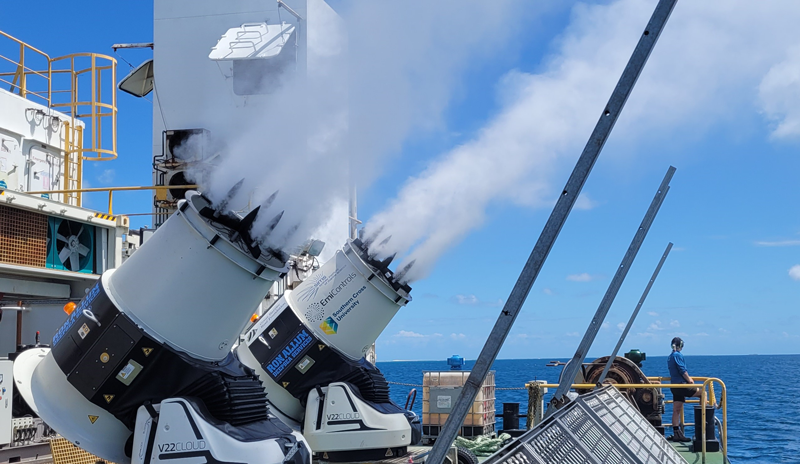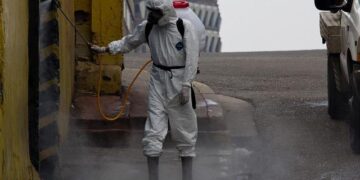Imagine this: It’s the year 2033, and the government agency that manages Australia’s Great Barrier Reef learns of intensifying heat in the Pacific Ocean. A tongue of water, its high temperature represented as dark red in satellite imagery, is moving westward from the tropical Pacific. From the United States, NOAA’s Coral Reef Watch issues a high alert for mass bleaching throughout the Great Barrier Reef. The oncoming heat could sear the corals that have built the 3,000 reefs that comprise the world’s most massive biological structure on Earth, turn them ghostly white, and destroy the abundant life they support. It could be catastrophic. It has been before.
But unlike in the past, people responsible for the Great Barrier Reef’s health need not sit idly by as the corals turn skeletal. They have what used to be a controversial tool at their disposal.
About a month before the heat wave arrives, a fleet of hundreds of ships sets sail. Bolted onto each fantail is something that looks like a snow-making machine, but its several thousand nozzles are optimized to turn seawater into mist. From a distance, each ship trails a white plume.
With more sunlight scattered back into space, less heat and light hit the reef.
The most important particles of the mist, each just a few microns in diameter, are too small to see with our eyes, but many trillions are there. They float above the sea’s surface until water molecules evaporate, leaving behind sea salt crystals that hitch a ride on rising air into low-lying clouds. There, water vapor coalesces around each crystal. Much like the extra fat globules in whole milk compared to skim milk, the extra droplets have the effect of making the clouds brighter. With more sunlight scattered back into space, less heat and light hit the reef; the water below stays cool, offsetting the approaching heat wave.
After it passes, divers take to the water and observation planes to the skies along the Great Barrier Reef’s 1,400-mile extent. A few reports of bleaching trickle in, some of it transient, some of it fatal—but, overall, the reef has weathered the heat storm. Its intricate architectures, comprised of hundreds of species of corals, retain their rich greens, ochres, and browns. Those pigments, produced by the symbiotic algae the coral relies upon for its energy, are the colors of health. Tens of thousands of species of fish, crabs, worms, urchins, and other marine marvels continue to dart and crawl through the reef’s filigreed branches and boughs. The cloud-brightening ships return to their ports and await the next deployment.
Make no mistake: This optimistic scenario is currently fiction. But it is fiction based on possibility.
Following devastating heat waves in 2016 and then 2017, which caused intense bleaching on the Great Barrier Reef’s northern and central sections and and made it impossible to ignore the existential vulnerability of coral in a warming world, Australia’s government established the Reef Restoration and Adaptation Program (RRAP). Their mission: figure out how to protect the reef. David Mead, the program’s director, called it a “no-stone-unturned approach.”
Scientists and engineers floated scores of ideas, many of which pushed the bounds of conventional coral conservation. Suggestions included deep-freezing coral so they could be revived when the Earth cools again; genetically modifying them to survive hotter seas; building coral farms where heat-adapted corals could be grown and then replanted in the wild; relocating corals to cooler places; treating reefs with probiotics; and finding ways to cool reefs.
 IT’S A BIG DEAL: More than 1,400 miles long, with an area of 133,000 square miles, Australia’s Great Barrier Reef is the largest coral system on Earth. Photo by superjoseph / Shutterstock.
IT’S A BIG DEAL: More than 1,400 miles long, with an area of 133,000 square miles, Australia’s Great Barrier Reef is the largest coral system on Earth. Photo by superjoseph / Shutterstock.
Perhaps water could be pumped to the surface from colder depths. Vast cloth shades might be strung between giant floats, or floating chalk powder used to make the sea surface reflective. Maybe a carpet of tiny bubbles blown from a floating platform could do the same. One group suggested using a fogging system to create low-lying mist. Among the ideas greenlighted was cloud brightening. It seemed like something that could actually be scaled to the size of the Great Barrier Reef—if, of course, it actually worked.
The first experiment took place in March 2020. Dan Harrison, an oceanographer and engineer at Southern Cross University who heads RRAP’s Cooling and Shading program, and his team set sail from Townsville, about midway along the reef’s extent. They turned on compressors that pumped seawater into a tenth-scale version of a cloud brightener and released sea mist over the reef. Meanwhile, a drone and a second boat criss-crossed the plume, taking measurements.
The demonstration wasn’t designed to change the clouds or the underlying temperature, but rather to measure the size of particles created and the plume’s extent. When the analysis was complete, the results were promising, with the correct-sized particles successfully created and traveling kilometers farther than predicted. Subsequent field experiments led to improvements in cloud brightener design. For example, the nozzles now pump 10 times more aerosols per second, thus decreasing energy demands. The team is investigating powering their operations without burning fossil fuels.
This optimistic scenario is currently fiction. But it is fiction based on possibility.
Important lessons have also been learned from extensive modeling, Harrison says. On a video call he pulled up a map on his computer screen and pointed at the depth of the seafloor off of northeastern Australia, where the Great Barrier Reef occupies 340,000 square kilometers. “See how flat it is?” Harrison moved his cursor along the wide continental shelf. “It’s an average of about 30 or 40 meters deep; it’s very shallow. It’s a huge lagoon where the circulation with the Pacific Ocean is very much cut off. So water exchanges slowly through these 3,000-and-something reefs. The reason that cloud brightening can work for the Great Barrier Reef is that you’ve got all of this water trapped here.”
Models show that cloud brightening at fully operational scales would only decrease water temperature by a tiny fraction each day. But if the water stays trapped for four to six weeks, the effects compound and eventually stabilize temperatures in the face of a heat wave. “You hit the balance between new, warmer water coming in and cooler water going out,” Harrison explained.
Atmospheric conditions must be favorable, too. Clouds in places with lots of air pollution, pollen, and dust are already nearly as bright as they can be, so adding salt crystals would have minimal impact. But in Australia, especially in summer, air flowing over the Great Barrier Reef comes from the southern Pacific Ocean. “It’s some of the cleanest air outside the poles,” Harrison said. The modeling has shown that each salt crystal lofted skyward has a maximal impact on brightening.
Although early results are promising, Harrison cautions that a debut is still many years off. Figuring out exactly where to brighten, when to brighten, and how much area to brighten is still unresolved. Field demonstrations at the scale that induces a change in temperature haven’t yet been reported. There are engineering challenges involved in scaling up capacity to the entire reef.
Uncertainties also remain about how cloud brightening might influence rainfall patterns—which leads to the question of how this intervention would be managed. When the idea was first theorized in 1990, it was controversial because it was proposed as a way to mitigate global climate warming and lumped in with speculative technologies called geoengineering. Questions were raised about uncertainties of effects on global weather patterns, impacts on marine life besides coral, and changes to marine photosynthesis, which is an important part of the global carbon cycle. There were formidable ethical questions, too. If clouds are used to cool the planet, what incentive is there to reduce greenhouse gas pollution?
But that kind of planetary-scale cloud brightening is very different from what’s being proposed in Australia. Supporters have been clear that the scope of RRAP’s project is limited in both time and space, which makes it fundamentally different from projects with global impact.
 CLOUD COVER: As seawater in the plume evaporates, particles of salt will be left behind, eventually joining low-hanging clouds and allowing them to reflect more ocean-heating sunlight. Photo courtesy of Southern Cross University.
CLOUD COVER: As seawater in the plume evaporates, particles of salt will be left behind, eventually joining low-hanging clouds and allowing them to reflect more ocean-heating sunlight. Photo courtesy of Southern Cross University.
At a United Nations meeting on the governance of cloud brightening last year, Jan MacDonald, an environmental law scholar at the University of Tasmania, pointed out that the Great Barrier Reef already has very strict management policies. Cloud brightening isn’t without risk, she said, but that calls for incremental, step-wise experiments rather than paralysis. “Each time you make an assessment of what’s been learned, what the issues are,” she said. Any deployment will require evaluation and approvals through public consultations, stakeholder engagement, and participation by the Indigenous people who are the Great Barrier Reef’s traditional owners.
According to Rob Wood, a climate scientist at the University of Washington’s Marine Cloud Brightening group, who is not involved in the Australian efforts, the fact that much remains unknown about cloud brightening is precisely why Harrison’s experiments are critical. “This is responsible research to be doing,” he said. As warming waters threaten reefs, there will be “calls for doing some kind of intervention. And we’re not going to be ready if we haven’t done any of the preparatory research.”
Yet even if the scaling and regulatory obstacles are overcome, a fleet of mist-emitting ships won’t protect the Great Barrier Reef forever. Humanity still has to curb climate change. Modeling currently suggests that cloud brightening “only works under a Paris-type scenario,” Harrison said, referring to global commitments to curb planetary warming.
“It gives you a decade or two. But there’s a limit to the amount you can brighten the clouds,” he said. Unless we get our carbon emissions under control, the Great Barrier Reef’s future will still be dim. ![]()
Lead image: Coral Brunner / Shutterstock.
Juli Berwald
Posted on October 11, 2023
Juli Berwald is a science writer and author of Spineless: The Science of Jellyfish and the Art of Growing a Backbone and Life on the Rocks: Building a Future for Coral Reefs. More about her writing can be found at juliberwald.com.
Published in partnership with:
Get the Nautilus newsletter
Cutting-edge science, unraveled by the very brightest living thinkers.
>>> Read full article>>>
Copyright for syndicated content belongs to the linked Source : Nautilus – https://nautil.us/a-wild-idea-to-protect-the-great-barrier-reef-413426/






























